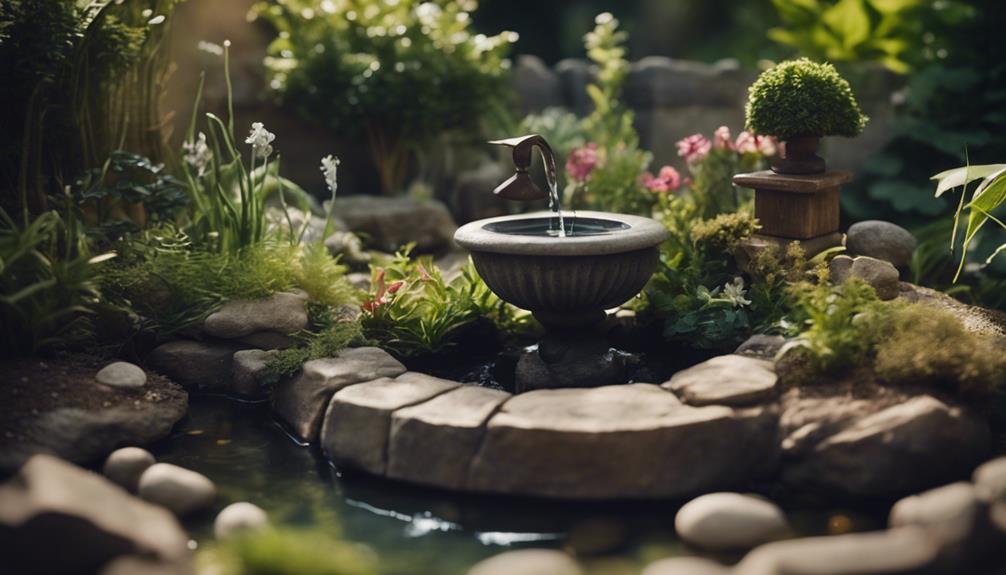When designing a small garden water feature, you'll need to prioritize essential systems, including a pump with a minimum flow rate of 100-200 gallons per hour, a filtration system, and a site selection that considers factors like sunlight, weather patterns, and visibility. A minimum depth of 18-24 inches is also required to support aquatic life and prevent stagnation. By incorporating these essential systems, you'll create a thriving and visually appealing water feature that enhances your outdoor space. Now, explore the various types of water features and design considerations to bring your vision to life.
Table of Contents
Key Takeaways
- A minimum depth of 18-24 inches is required to support aquatic life and prevent stagnation in small garden water features.
- A pump with a minimum flow rate of 100-200 gallons per hour is necessary for water circulation and oxygenation.
- A filtration system, such as a submersible filter or a skimmer, is essential to remove debris and excess nutrients.
- Accessibility for regular maintenance, such as cleaning and water testing, is crucial for small garden water features.
- Proximity to a water source and electricity outlet is important for maintenance and upkeep of small garden water features.
Small Water Feature Essentials
When designing and installing a small water feature, it's essential to incorporate essential components that guarantee a thriving ecosystem, starting with a minimum depth of 18-24 inches to support aquatic life and prevent stagnation.
This depth allows for a diverse range of aquatic plants to flourish, creating a natural habitat for small fish and other aquatic creatures.
You'll also need to install a pump with a minimum flow rate of 100-200 gallons per hour to maintain water circulation and oxygenation, ensuring your small fountain or small backyard water feature remains healthy and vibrant.
A filtration system, such as a submersible filter or a skimmer, is also pivotal to remove debris and excess nutrients that can lead to algae growth and water quality issues.
Types of Water Features Explained
As you consider adding a water feature to your small garden, you'll want to explore the various options available to you.
From fountains that create a striking visual focal point to miniature ponds that support aquatic life, each type of water feature offers unique benefits and design possibilities.
Fountain Options Available
Your small garden water feature can take many forms, thanks to the diverse range of fountain options available, which cater to various styles, spaces, and budgets.
From copper to cement, brass to stainless steel, the materials and designs are endless. Birdbaths, for instance, are a great way to attract birds and add visual interest to your garden.
Japanese Water gardens often feature serene water basins, creating a peaceful atmosphere. If you're looking for something more compact, bubbling containers are an excellent choice.
They're easy to create and can be customized to fit your backyard water feature style.
For a more dramatic effect, consider a small waterfall. You can design it to fit your space, with options for vertical or horizontal flows.
This will add a visually appealing element to your garden or outdoor space. With so many fountain options available, you can create a unique and personalized water feature that reflects your style and complements your garden.
Whether you're looking for a peaceful retreat or a vibrant focal point, the right fountain can bring your small garden water feature to life.
Water Feature Designs
By incorporating diverse water feature designs into your small garden, you can craft a unique and enchanting space that reflects your personal style and complements the surrounding landscape.
Fountains, for instance, can become a stunning focal point, adding visual interest and creating a relaxing ambiance. You can choose from various materials, such as copper, cement, brass, or stainless steel, to match your garden's aesthetic.
If you prefer a more natural look, consider a miniature pond, which can support small fish and aquatic plants. A minimum depth of 2 feet and width of 3 feet, along with a shelf for planting vegetation, will create a thriving ecosystem.
Birdbaths are another excellent option, attracting various bird species and providing a source of water. You can even heat them during winter to keep the water from freezing.
For a more serene atmosphere, Japanese water gardens can create a peaceful retreat, often featuring natural elements like stone, gravel, and carefully pruned plants.
Rock ponds or rock gardens can also add a unique touch, using various sizes, shapes, and colors of rocks and boulders to accent your space. These designs can create a compact backyard water feature that's both visually appealing and functional.
Small Space Solutions
When working with limited space, it's imperative to choose a water feature that not only fits your garden's dimensions but also complements its aesthetic, and that's where small space solutions come into play.
For instance, fountains are a versatile option, available in various shapes, sizes, and materials, making them perfect for small gardens.
If you're looking for a more serene atmosphere, consider a miniature pond, which requires a minimum depth of 2 feet and width of 3 feet, with a shelf for planting vegetation.
Birdbaths are another excellent addition to small outdoor spaces, attracting various bird species and providing visual appeal.
You can even heat them for use during winter months, keeping the water from freezing.
Rock ponds or rock gardens use various sizes, shapes, and colors of rocks and boulders to accent a space, providing a natural and low-maintenance water feature option.
Finally, bubbling containers are a compact and easy-to-create backyard water feature that can be customized to fit your individual style.
These small space solutions offer a range of options that cater to your specific needs, providing a beautiful and tranquil oasis in even the smallest of gardens.
Design and Installation Considerations
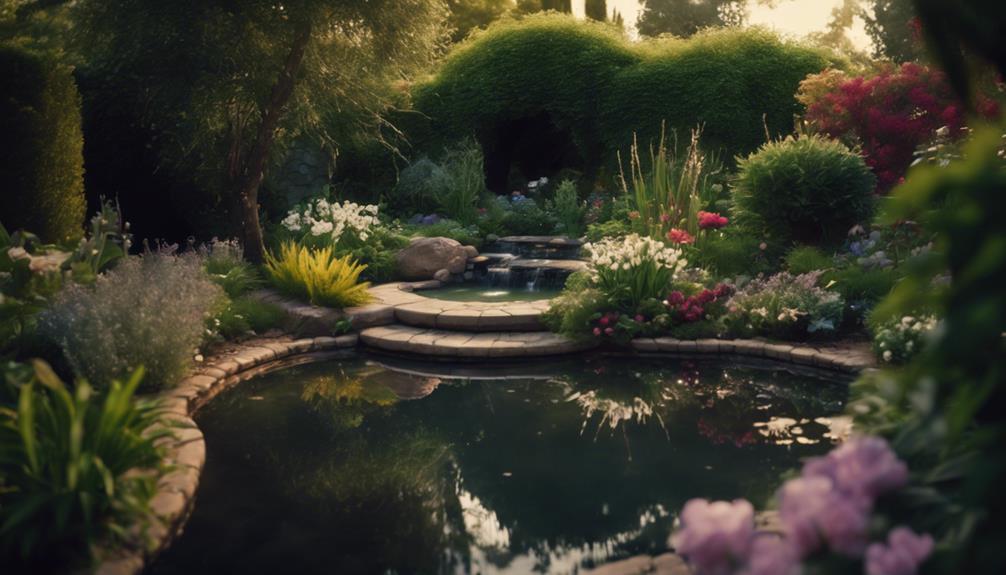
As you plan your small garden water feature, you'll need to carefully consider the site selection criteria to guarantee a harmonious and functional installation.
You'll want to evaluate factors like sunlight, weather patterns, and visibility from the house and seating areas to determine the ideal placement for your water feature.
Site Selection Criteria
Selecting the right site for your small garden water feature involves carefully evaluating the area to certify it meets specific criteria, including sunlight exposure, terrain, and accessibility.
When it comes to site selection, you'll want to choose a spot that receives at least 4-6 hours of direct sunlight per day, as most aquatic plants require this amount of light to thrive. Take a close look at the terrain around your proposed site, verifying it's level and even.
Uneven terrain can lead to water accumulation and erosion, which can be detrimental to your water feature.
Consider the proximity of your site to a water source and electricity outlet, as this will make maintenance and upkeep easier. You'll also want to guarantee the site is easily accessible for regular maintenance, such as cleaning and water testing.
Avoid areas with standing water or where water tends to collect, as this can lead to waterlogging and root rot in surrounding plants.
Water Feature Placement
Positioning your small garden water feature strategically involves carefully balancing aesthetics with functionality to create a harmonious and thriving environment. You want to choose a spot that complements your garden's layout, taking into account the surrounding landscape, foot traffic, and maintenance access.
When deciding on water feature placement, consider the following key factors:
| Factor | Consideration |
|---|---|
| Viewing Angle | Place the feature where it can be easily viewed from a seating area or patio, creating a sense of serenity. |
| Electrical Access | Verify the feature is close to a power source to avoid complicated wiring. |
| Water Supply | Position the feature near a water source, such as a hose or spigot, for easy refilling. |
| Drainage | Avoid placing the feature in low-lying areas where water may collect, causing maintenance issues.
Sunlight and Weather Factors
When incorporating a small garden water feature into your outdoor space, you'll need to carefully consider the amount and direction of sunlight it receives, as well as its exposure to various weather conditions, to guarantee prime performance and aesthetics.
Aim for a spot that receives at least 4-6 hours of direct sunlight per day to maintain clean and clear water. Partial shade can be tolerated, but full shade can lead to excessive algae growth and decreased water quality.
Strong winds can also disrupt water flow and increase evaporation, so selecting a location that provides protection from gusty weather is crucial. Consider the direction of sunlight and wind patterns when determining the placement of your water feature to secure peak performance and aesthetics.
Additionally, design the surrounding landscape and hardscape to absorb and redirect rainwater, reducing the risk of water feature overflow and erosion. By carefully considering these factors, you can create a thriving and beautiful small garden water feature that enhances your outdoor space.
Maintenance and Upkeep Strategies
By incorporating a regular cleaning schedule, you can prevent debris buildup and maintain the aesthetic appeal of your small garden water feature.
This easy-to-maintain approach guarantees your water feature remains a serene oasis, rather than a neglected eyesore.
For a hassle-free maintenance routine, set aside time each week to skim the surface for floating debris, clean the pump and filter, and check the water level.
You can also perform a deeper clean every few months by draining the water and scrubbing the basin and surrounding areas.
Regular upkeep not only preserves the visual appeal of your water feature but also prevents clogs, reduces energy consumption, and extends the lifespan of your equipment.
Plants and Landscaping for Water Features
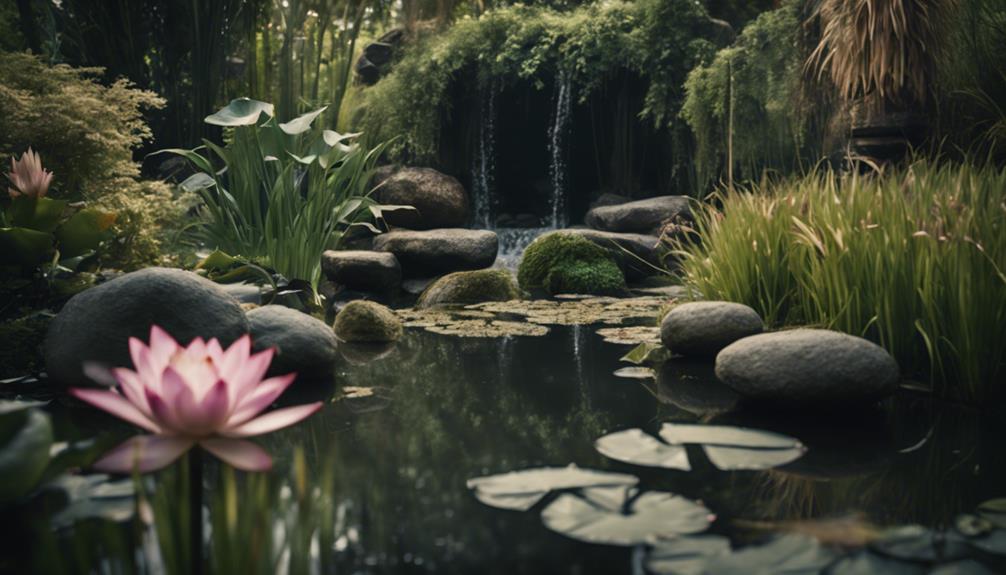
As you design your small garden water feature, incorporating the right plants and landscaping elements can elevate its visual appeal, creating a serene and inviting atmosphere that draws you in. The right plants can add a natural touch, provide shade, and filter the water, creating a self-sustaining ecosystem.
Some plants and landscaping ideas to ponder for your water feature:
Aquatic plants like water lilies and marginal plants like irises and rushes can provide shade, filter water, and create a natural ambiance.
Japanese water garden plants, such as lotus and water hyacinth, can add a unique touch and require minimal maintenance.
Rock gardens with succulents and creeping thyme can create a natural-looking environment that requires minimal upkeep.
Flowering plants, grasses, and mosses can thrive in wet conditions and add color and texture to your water feature.
Waterfall and Fountain Options Explored
As you consider incorporating a waterfall or fountain into your small garden, you'll want to weigh the design elements that will create a visually stunning display.
You'll need to think about the type of waterfall that will work best for your space, whether it's a natural-looking rockfall or a more modern, sleek design.
Waterfall Design Elements
When designing a small garden waterfall, you'll want to carefully select the rocks, materials, and other elements that will bring your vision to life, as these details will substantially impact the overall aesthetic and functionality of the feature.
The type of water, sound of water, and visual appeal all play a vital role in creating an inviting atmosphere.
To achieve this, consider the following waterfall design elements:
Rock selection: Choose rocks that complement the surrounding landscape and create a natural-looking environment.
Water flow rate: Adjust the flow rate to achieve the desired sound of water, from gentle trickling to a more dramatic cascade.
Materials and textures: Combine rocks, plants, and lighting to create a visually appealing feature that attracts wildlife and adds ambiance to your outdoor space.
Pond or pondless design: Decide between a traditional waterfall with a pond or a low-maintenance pondless design that reduces water loss and maintenance needs.
Types of Waterfalls
You can choose from two main types of waterfalls: traditional waterfalls that feature a pond with a decorative waterfall, often accompanied by plantings and fish, and pondless waterfalls that involve water cascading down rocks or a stone wall onto ornamental gravel.
Traditional waterfalls are ideal for those who want to create a serene environment with a thriving ecosystem. You can customize them with features like rock formations, waterfalls, and caves to create a unique landscape. However, they require regular maintenance to keep the water clean and clear.
On the other hand, pondless waterfalls are perfect for small spaces and require minimal maintenance. They can be designed to fit miniature gardens, with options for vertical or horizontal flows. You can create a natural-looking environment by adding plants, rocks, and other decorative elements.
With pondless waterfalls, you can enjoy the soothing sound of running water without the hassle of maintaining a pond. Both types of waterfalls offer versatility and customization options, allowing you to create a unique and peaceful oasis in your small garden.
Pondless Waterfall Options
Pondless waterfalls offer a range of options, from compact, self-contained units to custom-built systems that incorporate fountains, cascades, and other decorative elements to create a visually striking display.
When designing your small garden water feature, you'll want to ponder the space available, the sound and visual effects you desire, and the level of maintenance you're willing to commit to.
A series of small waterfalls that cascade down a staircase-like structure, creating a soothing sound and visual interest, are known as stairway water.
Compact units that can be attached to a wall or fence, providing a space-saving solution for small gardens, are wall-mounted systems.
Discreetly installed systems that blend seamlessly into your garden landscape, creating a natural-looking waterfall effect, are in-ground units.
Interchangeable components that can be combined to create a customized pondless waterfall that suits your unique needs and style are modular systems.
Japanese Garden Design and Water Features
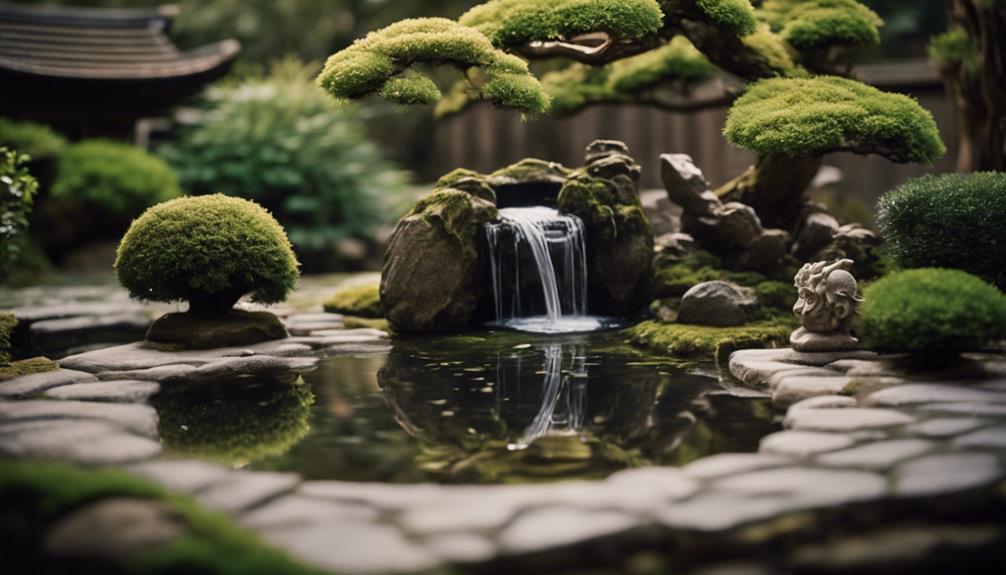
Three essential components of traditional Japanese garden design – stone, plant life, and water – harmoniously converge in serene and visually striking water features that reflect the country's cultural and spiritual heritage.
As you design your small garden water feature, you'll want to incorporate these elements to create a tranquil oasis.
Consider installing a small stream that meanders through your garden, its gentle babble creating a soothing atmosphere.
A stone fountain, strategically placed among lush greenery, adds visual interest and creates a sense of calm.
To create a sense of continuity, choose stones with unique textures and colors that complement your garden's overall aesthetic.
When selecting plant life, opt for species that thrive in moist environments, such as Japanese maples, mosses, and ferns.
By thoughtfully combining these elements, you'll create a Japanese-inspired water feature that invites contemplation and relaxation.
With careful planning, your small garden will become a serene retreat that embodies the essence of Japanese garden design.
Birdbaths and Wildlife Attraction
Attracting a diverse range of bird species and providing a vital source of water for drinking and bathing, birdbaths are a thoughtful addition to outdoor spaces that can be tailored to meet the specific needs of local wildlife.
By incorporating a birdbath into your small garden water feature, you'll not only attract birds but also create an aesthetically pleasing focal point.
To create a welcoming space for birds and other wildlife, consider the following design elements:
- Heated birdbaths for year-round access to water
- Fountain mist to attract hummingbirds and other species drawn to moving water
- Gradually sloping walls, nonslippery surfaces, and shallow water (less than 3 inches) for bird safety
- Built-in plant shelves or marginal areas to incorporate aquatic plants, which filter the water and create a natural habitat
Spas and Relaxation in Small Spaces
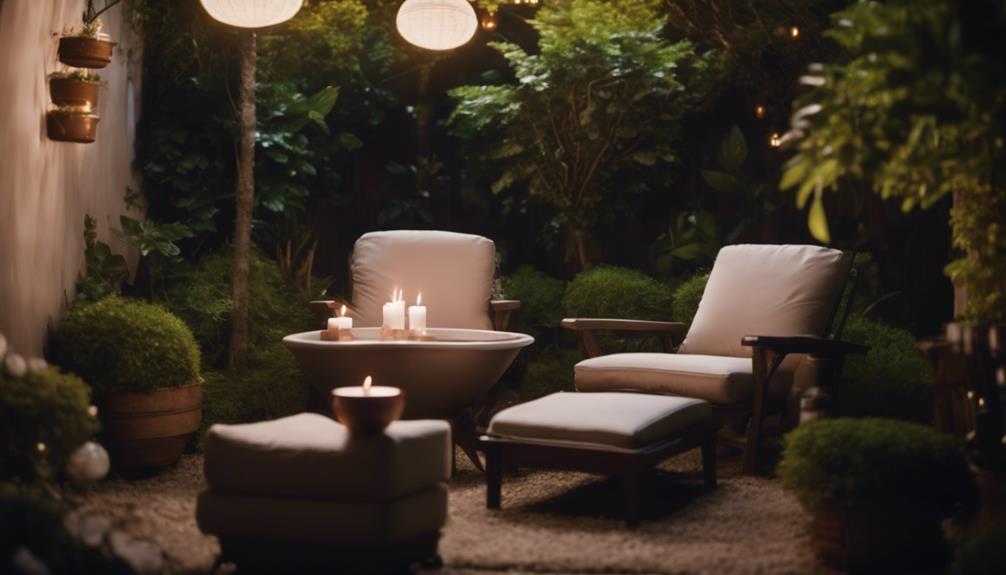
As you shift your focus from attracting wildlife to creating a serene oasis, a thoughtfully designed spa in your small garden can become a luxurious retreat, perfect for unwinding and rejuvenating in the comfort of your own backyard.
Compact spa models are available, specifically designed to fit snugly into tight spaces, such as corners or against walls, while still providing a relaxing experience.
When choosing a spa for your small space, consider the number of users, desired features, and energy efficiency to guarantee the right fit for your space and budget.
Imagine sinking into the warm, soothing waters, surrounded by the gentle sounds of nature, and letting the stresses of the day melt away.
With regular maintenance, your outdoor spa can be enjoyed year-round, and with heating and cooling systems, you can customize the experience to suit your preferences.
Unique and Creative Water Features
Beyond the tranquility of a spa, you can further enhance your small garden's ambiance by incorporating unique and creative water features that add visual interest, soothing sounds, and a touch of whimsy to your outdoor space. These features can transform your miniature ponds and gardens into inviting oases that beckon you to relax and unwind.
Stairway water features combine a waterfall and fountain, creating a unique and surprising element in your garden.
Water basins can be used to create a decorative bowl that catches water from a nearby spout, adding visual interest and creating a soothing sound.
Rock gardens can be used to create a natural-looking waterfall or spout, with options for incorporating plants and other decorative elements.
Pondless waterfalls involve water cascading down rocks or a stone wall onto ornamental gravel, creating a visually appealing and low-maintenance water feature.
Essential Systems for Small Ponds
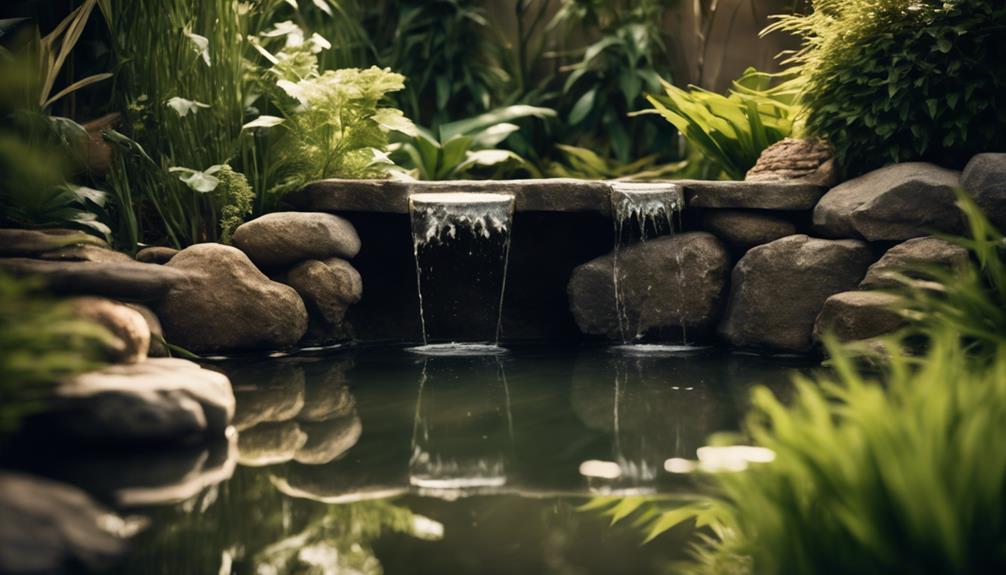
You'll need to implement a few essential systems to maintain a healthy and thriving small pond ecosystem, including a pump and filtration system to keep the water circulating and clean.
A pump will help oxygenate the water, while a filtration system will remove debris and excess nutrients that can lead to algae growth. When choosing a pump, weigh the proper pool size for your small pond. A variety of sizes are available, so select one that matches your pond's dimensions. For example, a 1/2 horsepower pump is suitable for small ponds up to 1,000 gallons.
In addition to circulation and filtration, you'll also need to ponder aeration and skimming systems.
Aeration systems introduce oxygen into the water, promoting healthy aquatic life. Skimming systems remove surface debris, such as leaves and insects, before they sink to the bottom and decay.
Frequently Asked Questions
What to Put in a Small Garden Water Feature?
When designing your small garden water feature, you'll want to ponder water plant options like irises and cattails, then add fountain sounds with a small pump and create visually appealing pebble arrangements to complete the ambiance.
What Is Needed for a Water Feature?
You'll need a reliable water pump, choosing between electric or solar-powered options, and selecting durable pipe materials that resist corrosion. Don't forget to prioritize electrical safety measures, ensuring your water feature operates smoothly and safely.
What Is the Easiest Water Feature to Maintain?
You'll be surprised to know that 75% of water feature owners prefer low-maintenance options! For you, the easiest water feature to maintain is a bubbler, thanks to its pondless design, self-circulation system, and minimal impact on water quality, making it a hassle-free choice.
How to Make a Mini Water Feature?
You'll create a mini water feature that's a Water Saver, Space Optimizer, and DIY Delight by selecting a shallow container, a low-flow pump, and adding decorative elements like rocks and plants to conceal the equipment and create a soothing atmosphere.
Conclusion
As you gaze out at your small garden water feature, remember that it's not just a pretty sight – it's a thriving ecosystem.
In fact, did you know that a single small pond can support up to 100 species of plants and animals?
By incorporating essential systems, carefully designing and installing your feature, and maintaining it properly, you'll create a haven for wildlife and a peaceful retreat for yourself.

